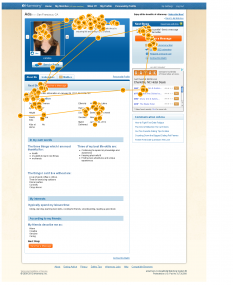Tobii’s Eye-Tracking Tech Knows What You’re Eyeing on Dating Sites
Tobii’s Eye-Tracking Tech Knows What You’re Eyeing on Dating Sites
February 6, 2012 at 8:00 am PT
When it comes to scouring dating sites, men tend to look at the pictures more, while women’s eyes linger longer on the text.
We probably didn’t need a formal study to tell us that. 
But that’s exactly what Tobii, maker of eye-tracking technology, set out to do.
The Sweden-based company, in collaboration with AnswerLab, recently pounced on a bunch of people at a San Francisco coffee shop and asked them to participate in a study in which they’d be examining the dating profiles of members of the opposite sex — and during the session, their eye movements would be tracked by Tobii’s sensors.
After participants viewed mock-up pages of eHarmony.com and Match.com profiles, the verdict was in: Men spent 65 percent more time than women did reviewing photos in profiles; women spent 50 percent more time reading the text about a potential mate’s background and interests.
Women also spent an average of 84 seconds gazing at a profile to determine if it was a match, compared to 58 seconds for men.
The study also revealed that people tend to like dating profiles that they feel are more reflective of the kind they would build for themselves. For example, people that prefer to share lots of personal info gravitated more toward very personal dating profiles, while those that stick to “just the facts, ma’am,†liked profiles that had simpler demographic info and data.
Tobii uses tracking technology that zeroes in on a user’s pupil and calculates the point of gaze using algorithms. For heavy blinkers or those with shifty eyes, the recovery time of Tobii’s sensor is between 100 and 300 milliseconds; it draws an “imaginary box†around the user’s head to account for lots of head movement, as well.
For more info on how it works, check out this video from D9, where Tobii general manager Barbara Barclay demoed how Tobii could help users control their laptops with just their eyeballs. Late last month, the company introduced its X1 Light Eye Tracker, marketed mainly to usability and market researchers.
To demonstrate the usefulness of its eye-tracking tech at the consumer level, Tobii is planning to conduct more studies and present more interesting use cases, Barclay said. The next study, for example, might be even more precise: Instead of examining who is looking at pictures versus text, the next study might shed light on which area of the pictures people’s eyes tend to linger on. (We know what you’re thinking right now.)
Ultimately, these types of studies could be most useful for advertisers, as well as Web companies.
The study showed that when there was a great deal of ad content on the right-hand side of a profile page, participants would be distracted by the ads and avert their eyes from the profile information. Great news for advertisers, but bad news for those who want to remain focused on the task at hand.
It’s important to note that the sample for this study was very small: The company managed to convince more than 40 people to try it out, but had to throw away a handful of samples due to inconclusive data, which can be caused by certain types of glasses, lazy or droopy eyes, or an extreme amount of gaze-shifting.
But Tobii’s Barclay says continued testing could help companies determine monetization strategies and how they might conflict with the ultimate goal of a Web site’s content, or to help advertisers make ads more relevant and boost click-through rates.
(Feature photo courtesy of Flickr)
